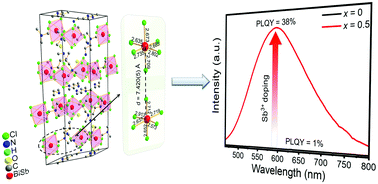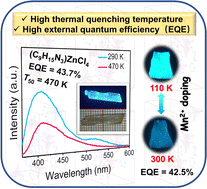Inorg. Chem. 2022, 61, 19, 7560–7567.https://doi.org/10.1021/acs.inorgchem.2c00711

Organic–inorganic metal halides (OIMHs) exhibit excellent photoelectric properties; however, their high-temperature light-emission stability requires further improvement. Here, we report three isostructural OIMHs (C2H8N)4InCl7, (C2H8N)4SbCl7, and (C2H8N)4SbBr7 (C2H8N+ = dimethylammonium). They are all crystallized in the P21212 space group with a zero-dimensional (0D) structure, with orange-red photoluminescence (PL) under 365 nm UV excitation. Among them, (C2H8N)4InCl7 exhibits the strongest PL with a photoluminescence quantum yield (PLQY) of 13.9% at room temperature. Optical property measurements and density functional theory unveil that the luminescence of (C2H8N)4InCl7 at 405 and 620 nm is due to free exciton and self-trapped exciton emission, respectively. It is worth noting that (C2H8N)4InCl7 shows a high PL quenching temperature, maintaining 50% of its room-temperature PL intensity at 425 K, which is rare in OIHMs. This is much higher than the application temperature of phosphors in practical solid-state lighting applications (363–383 K). In this temperature range, the luminous intensity of (C2H8N)4InCl7 exceeds 60% of that at room temperature. The high PL quenching temperature observed in (C2H8N)4InCl7 indicates the potential of OIMHs for applications in phosphor-converted light-emitting diodes.









